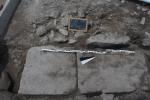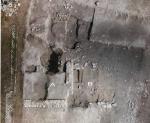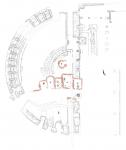Summary (English)
The continuation of research in the forum area provided a wider view of the destructive interventions in the late antique period, already documented during previous campaigns in trench 79. Robber trenches, middens, and the razing of the structures for agricultural purposes have heavily compromised the evidence of the city’s occupation phases and the use of the area after the 5th century A.D. earthquake caused it to be abandoned. The enlargement of the excavation area showed that in the late antique period, the large midden inside room A had made use of a cistern dug into the silt prior to the Roman constructions.
Parts of the north and south walls were preserved in the adjacent room B, the closing east wall was completely missing. The materials from the latter were present in the area. A vast and irregular layer of imbrices attested the roof collapse.
The materials from the layer of burning inside room A and extending across most of the area confirmed that the structures were abandoned within the 5th century A.D.
Continuation of the excavation in a small sector revealed two limestone blocks bonded with mortar, and fragments of others that were residual elements from the forum context.In the eastern zone of the forum, the sector was enlarged where excavations in the 1990s had identified part of a room (E), of which the north side was identified. Inside the room, in the new sector, several layers of building rubble were uncovered, relating to the same number of collapses, which seem to attest a gradual falling into ruin of the structure, like rooms A and B, belonging to a phase when the forum was reused. In fact, the impressions of slabs probably belonging to the forum paving were present in the layer below the floor made up of tile and imbrices fragments.
Theatre Area
Excavations also continued in the theatre area where there were several phases of use. Part of the building’s southern sector was occupied in the Renaissance period by a series of rooms (α-ζ) functional for the demolition of the building. The deepening of the excavation inside room γ revealed the remains of the south wall, in which one of the two doorjambs from the original entrance was preserved.
Excavation also continued to the north of rooms γ, δ and ε, the area corresponding with the original theatre orchestra. The stratigraphy related to the fill of the cavea, constituted by materials from the theatre and temple collapses following the earthquake and, subsequently by dumps from robbing activities. The excavations recovered new architectural and sculptural elements.
- Luisa Migliorati - Sapienza Università Roma
Director
Team
- A. Pansini - –Sapienza Università di Roma
- Claudia Micari
- Dario Canino
- Federica Pirré
- Giulio Casazza
- Ilaria Trivelloni - –Sapienza Università di Roma
- Leonardo Radicioni
- Luca Volpi
- Tiziana Sgrulloni- Archeoclub d'Italia sede Mentana-Monterotondo






![Download [PDF]](/excavation/skins/fasti/images/results/download_sml.png)

